It seems hard to me to accept that the engineers in 2011/2012 decided to implement a cutting edge codec that may change before it sees use for a feature that might see action, maybe, in limited cases of streaming content they didn't know what. If we're to take the AMD slide at face value, maybe we're talking about a new XB1 SKU with DVR functionality, the fables STB oft rumoured?
Anything thats restricted to streaming from a Xbox One to a windows based PC doesn't necessarily need a standard codec. As long as MS doesn't mind being limited to software decoding on the PC side when using whats basically a custom encoder.
Gary Sullivan who chaired and co-chaired h.264 and h.265 is MS's lead engineer of its DXVA api used by software decoders for hardware acceleration. And the first draft of the HEVC specs was released in 2010. Given the limited utility of HEVC encoding on the Xb1, could MS have gone with an earlier draft of HEVC?
Last edited:

